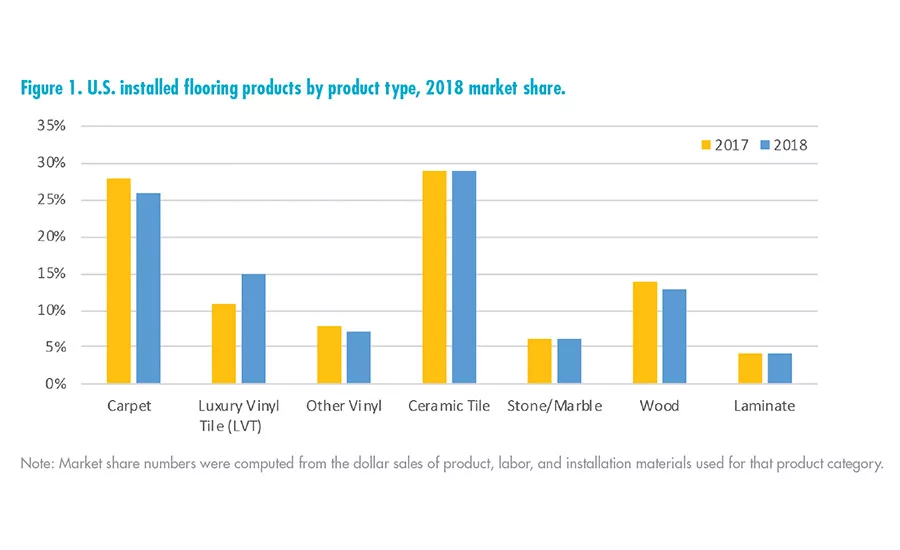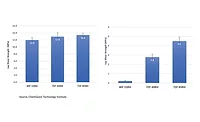Strategic Solutions
Evolving Hybrid Adhesives
This first installment of a two-part series highlights the value proposition of today's adhesive chemistries and curing methods to high-value end-use markets.

Hybrid adhesives have evolved to meet the bonding requirements for assembling today’s consumer products in the U.S. electronics and flooring industries. Flooring, including luxury vinyl tile (LVT) and planks, carpet tiles, and ceramic tiles, is growing in popularity in the big box retail channel (see Figure 11). According to a recent report, the domestic carpet market reached 11.5 billion sq ft in 2018, valued at $11.7 billion, while the LVT market (including gluedown, loose lay, and rigid core) was 2.7 billion sq ft valued at $3.4 billion.2 Builders can replace expensive stone with vinyl flooring embossed with images to produce an authentic-looking stone floor; a UV-curable system imparts either a flat or glossy finish to these surfaces.
Increasing the automation speed for modern flooring offers a significant (cost-reducing) advantage. The conventional curing method for waterborne material required several ovens to ensure a uniform cure. Replacing energy-intensive baking with UV light produced a simplified, cleaner cure in 1-5 sec.
Over the last decade, the advent of UV LED light replaced the conventional beam’s scattered-light effect on the substrate to ensure precision and good exposure for a superior cure. For example, the advantages of using a UV LED lamp are appreciable when assembling miniature components in a cell phone printed circuit board (PCB). Moreover, the 100% solids UV material reduces VOC emissions (eliminates solvents) and shrinkage while producing a tack-free bond.
Minimizing complexity (i.e., no mixing), advanced precision, and increased speed are key drivers in most markets today. One-component adhesive systems offering high-performance bonding characteristics typically associated with two-component systems are in demand by end-use customers for a broad range of flooring, electronics, and infrastructure adhesive applications. This demand is partially driven by periodic mixing and dispensing equipment failures (e.g., parts A and B aren’t mixed properly due to periodic jams or blockages in the line). One-component room-temperature-cure systems also eliminate the need for heat, which saves on energy costs and expands the types of substrate materials in use.
A hybrid system such as those combining a moisture-cure urethane (MCU) with a UV-curable acrylic adhesive offer “mix and match” advantages. A slower crosslink in some applications may produce a stronger bond. The benefits of a urethane may be better-suited to certain substrates. Acrylics, which are most commonly used in UV-cure systems, may not adhere to certain substrates. Epoxies that impart strength to a formulation may become brittle. In an epoxy hybrid system, UV-cure acrylic is blended in to impart resiliency and flexibility properties. Today’s customers are looking for these formulation options.
Addressing Trends
We’re seeing two notable trends: end users seeking new adhesive properties from suppliers, and suppliers going to market with new innovations to meet unmet market needs. For example, a defense contractor may have a small component adhesive specification that must also comply with a much larger specification such as a satellite dish. Customer specifications are commonly redefining adhesive strength, resiliency, and appearance. They are additionally requiring the use of sustainable raw materials to meet an industry standard; federal, state, or local mandate; or a cradle-to-cradle design.
By contrast, a supplier rolling out a new technology for a mature industry may present performance characteristics equal to or better than a customer’s existing product, but with incremental improvements that make the product cleaner, faster, and in most cases, more cost competitive. In the electronics industry, adhesive selection is specification driven, while other industries require certain performance characteristics that meet military-grade specifications or ASTM and other industry standards.
In another example, an intricate network of domestic pipelines transporting natural gas, biofuels, and liquid petroleum requires periodic maintenance. Repairing cracks in the pipelines historically involved the mechanical welding of a piece of metal to stop the leakage. In some cases, however, the mechanical weld can be replaced with a chemical weld such as encapsulation: the adhesive product is wrapped around the crack, where it cures in place by applying UV, an electron beam, or even a one-part MCU system.
Clearing Up Common Misconceptions
Quality in bonding is only achieved by matching individual application requirements with the appropriate adhesive system and understanding the tradeoffs. UV-curable acrylic adhesives are not one-size-fits-all. And a faster cure isn’t necessarily better; a failure over time may occur if the adhesive isn’t uniformly cured beneath the surface.
Another common misconception involves yellowing: higher cost UV-curable silicones are sometimes selected over UV-cure acrylics strictly to avoid yellowing. Whether yellowing is problematic depends on the application, however. When selecting a material to bond luxury vinyl tiles to a subfloor, for example, yellowing shouldn’t be a factor because the bond isn’t visible and yellowing doesn’t affect the bond quality.
References
- Trivers, Jonathan, “2018 marketWise,” Floor Covering Weekly, July 22, 2019, p. 14.
- “Statistical Report 2018: Surprise High,” Floor Covering Weekly, July 22, 2019, p. 11.
Looking for a reprint of this article?
From high-res PDFs to custom plaques, order your copy today!







